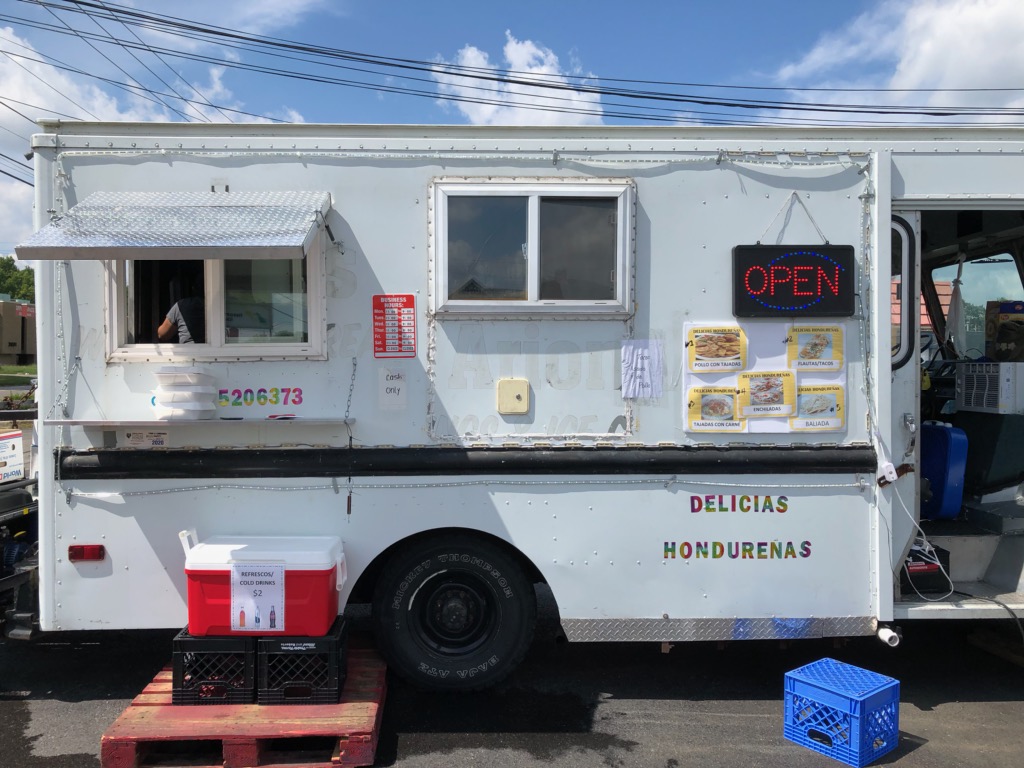“Ethnography’s commitment to writing from the ground is an impulse to stay open to what’s in your vicinity. But the ‘ground’ is not just a backdrop or a context; it’s the sensed social-material-aesthetic atmospherics resonant in a scene….” –Lauren Berlant and Kathleen Stewart, The Hundreds
The food truck showed up on a hot Monday morning near the end of August. It parked at the edge of a strip mall’s pitted asphalt lot, perpendicular to the Salvadoran grocery store. On its side, stick-on letters in rainbow colors read “Delicias Hondureñas.”
That Saturday, I waited in the parking lot for my platanos carnitas (fried green bananas with ground beef and pickled vegetables) and baleadas (flatbreads filled with refried beans and zesty liquid cheese). The owner, a burly man in basketball shorts and a black wicking shirt, stood outside the truck; inside, a middle-aged woman, her black hair pulled back tightly, worked the fryer and grills.
The food was taking a long time. A man named Francisco had ordered a lot, to take home to his wife and kids. He wore a gold golf shirt and green pants, the uniform of his small landscaping outfit.
Francisco apologized for his English. “My son’s English is very good,” he said. I apologized for my Spanish—woeful compared to his English. We exchanged fragments in our two languages.
He’d been working on a yard down the street and noticed the truck last week. He is from Honduras; he said the food really tasted like home. He’s been in the U.S. seven years and has four children, aged three to eighteen. “Mucho trabajo,” I said, and he laughed. I told him I was from the east coast and have been in Indiana veinte años. “Tiempo largo,” he said. He handed me a hang-tag with his business’s particulars.
The truck owner apologized for the delay. I photographed the phone number from the truck’s side, thinking I’d call ahead next time.
We grew silent. I noticed that I was wearing a mask while neither Francisco nor the truck owner were. I was also wearing sunglasses. I could see their eyes, and Francisco’s smile, but they couldn’t see mine.
Behind the truck, an African-American man in a black golf-shirt was running a gas trimmer over the patch of grass and weeds sprouting around a utility pole. Francisco watched the man work. Judging his technique? I wondered, and thought about the word “landscaping.”
I looked at the sky: blue streaked with cumulus. The weather had cooled and grown less humid. I looked around: the Salvadoran grocery, its window paint advertising “Productos de Centroamerica,” “Vegetales,” “Carnes,” and “EBT” on either side of a map of central America, the countries painted in the colors and designs of their flags. Across the wide lot, a blue house with a long ramp and white railing had been converted to a day care, “Accepting Clients and Applications.” Across the street, two white butterflies followed their knuckleball paths from bush to bush.
On the ride over, the radio news had been about the hurricane in the Gulf (the first of three, it would turn out); about movie theaters opening, perhaps unwisely; about the election coming down to “Covid-19 failures vs. law-and-order.”
I’d turned it off quickly. In this Pandemic summer, in which I’ve been working more than normal, on more emotionally fraught things than normal, I’ve tried to set Saturdays aside as true sabbaths: no work and no media.
Up walked a white guy and his son, about 10, in his baseball uniform. The father eyed the menu—one laminated picture for each of the five things the truck offered (tacos, enchiladas, baleadas, two kinds of platanas). He said to the boy, “Do you want to eat here or do you want to do something else?” The boy shrugged. The man put an arm over the boy’s shoulder, and they walked off.
Meanwhile a truck bearing the logo “Martinez Painting” had pulled up, three adults in the cab. From the store emerged a young woman with long, dark hair, wearing skinny jeans, her face masked in white. She ran joyfully to the truck and hugged the woman in the passenger seat.
The truck owner was stacking up Styrofoam meal containers: the painters had come for their takeout. Meanwhile a pony-tailed little girl, perhaps 4, was running back and forth between the store and the cab of the food truck. She wore rainbow colored sneakers and a pink shirt from which a llama eyed the viewer, the words “No problema” in fat letters to its right.
Now the painters had pulled away, and the owner was stacking Francisco’s food on the ledge outside the truck’s service window. Out came more Styrofoam meal containers, aluminum foil packets enfolding baleadas, and bulging freezer bags full of hot sauce. A young man dressed identically to Francisco, masked, walked up to help transport the food. “This is my son,” Francisco said. I told him I’d be calling them for Fall cleanup in a month or so. “Great!” he said, and offered me his elbow to bump.
I was left with the owner, who apologized again for the food taking so long. “The pollo takes a long time to cook,” he said. I said it was OK, and asked him how things we’re going. They’d been open a week and things were “really slow,” he said, shaking his head. “I want to move somewhere with more traffic. And maybe, I think, I need to serve more Mexican food.”
A week later, I called the truck’s number to order. The baleadas had been especially good, the creamy beans and avocado inside a slightly crunchy flatbread giving a comfort-food feel, the spicy cheese getting it up on its feet.
I said into the phone, “Hi, I want to order a couple baleadas for pick-up.”
“Oh,” he said, “We don’t have those no more.”
–Patrick Collier


